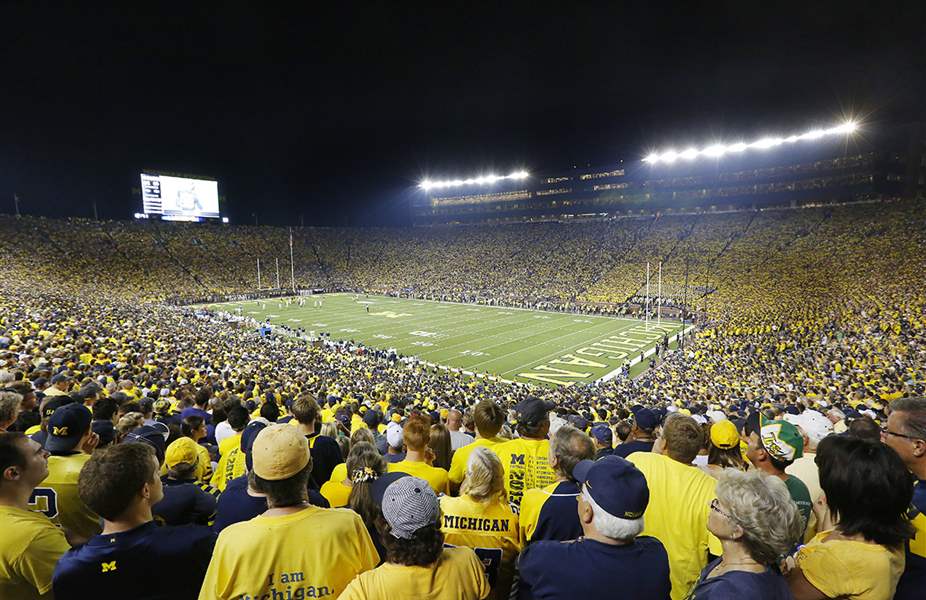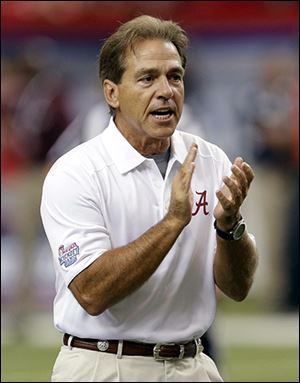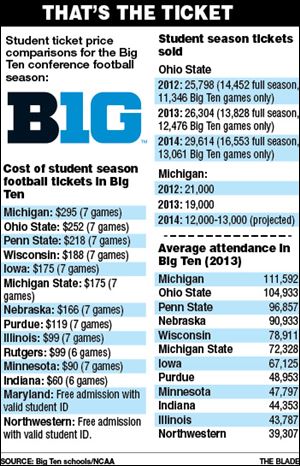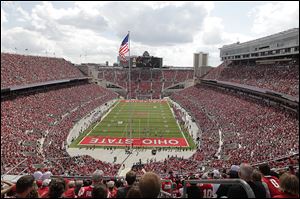
Ohio State's Horseshoe aims to upstage Michigan's Big House
UM’s student sales sink as Buckeyes brace for record crowds
7/6/2014
The Big House in Ann Arbor reached record attendance figures on Sept. 7, 2013. Michigan has reigned as college football’s attendance leader for 39 of the past 40 years. However, a trend of declining student ticket sales has hit hardest at Michigan.
THE BLADE
Buy This Image

The Big House in Ann Arbor reached record attendance figures on Sept. 7, 2013. Michigan has reigned as college football’s attendance leader for 39 of the past 40 years. However, a trend of declining student ticket sales has hit hardest at Michigan.
The Big House may no longer be the biggest this fall.
That title could soon belong to — gasp — the Stadium Down South.
While Michigan has reigned as college football’s attendance leader for 39 of the past 40 years, a perfect brew of events has positioned Ohio State to swipe the crown.
At the same time, OSU is bracing for record six-figure crowds at newly renovated Ohio Stadium — one prominent ticket broker calls the Buckeyes the hottest team in the country — Michigan faces its toughest sell in decades. Thousands of past ticket buyers are saying no thanks amid increased prices, decreased results, and a blah home schedule highlighted by a prime-time visit from Penn State.
Most telling is the veering paths of the rivals’ usually most loyal faction: the students.
A national trend
A nationwide trend of declining student ticket sales has hit hardest at Michigan but has been defied in Columbus.
Ohio State has had no trouble persuading undergrads that the spectacle inside the stadium is better than their buddy’s 60-inch high-definition television and beer-furnished refrigerator. With an unprecedented three home night games and the Buckeyes expected to contend for a national title, OSU sold ticket packages to 29,614 students — 16,553 who paid $252 for all seven home dates, 13,061 who will attend only the Big Ten games.
Michigan, meanwhile, expects to sell 12,000 to 13,000 student season tickets, said UM associate athletic director David Ablauf, down from about 21,000 in 2012 and 19,000 last season.
OSU’s 12 percent increase in student ticket sales combined with the exodus at Michigan could alone make the Horseshoe the most populous stadium in American sports.
Michigan averaged 111,592 fans last season to lead the nation in attendance for the 16th straight year. Ohio State was second with an average crowd of 104,933 and has since added 2,522 seats to the south stands in Ohio Stadium.
“We are definitely excited,” OSU assistant athletic director for ticketing Brett Scarbrough said of the student surge. “We had been watching the trends and were certainly curious about where we were going to end up. Obviously, we are very pleased with the results.”
No surprise
At Michigan, outgoing student body President Michael Proppe said he is not surprised by the low sales.

UM is not alone with its attendance problems. University of Alabama coach Nick Saban chided students for leaving games early at halftime.
Michigan raised its student ticket prices from $205 for six games in 2012 to a Big Ten-high $295 for seven games last year while implementing a controversial new seating policy. Whereas in past years students were seated by class, Michigan athletic director Dave Brandon made their sections general admission — a first come, first-served arrangement designed to prompt laggards to arrive early.
Instead, Mr. Proppe said the change alienated students because it made it difficult to sit with friends. The old policy returned this year, but many students did not.
“How’d Michigan lose so many students so fast?” author and Michigan historian John U. Bacon wrote in an essay on his Web site last month. “Answer: a lot of hard work.”
In a later phone interview, Mr. Bacon said, “It would be foolish to conclude you’re merely part of a national trend. Losing 40 percent of your students in two years is not the national trend. And it doesn’t take long to figure out if you don’t have the students, you will not have alums coming back to buy tickets.”
A once-robust cheering section will be a little quieter this year as Michigan sets off on a dreary home schedule. With rivalry games against Ohio State, Michigan State, and Notre Dame on the road, the lineup of visitors includes Appalachian State, Miami (Ohio), Utah, Minnesota, Penn State, Indiana, and Maryland. None had a winning conference record last season — Miami went winless, period — and, adding to the sting, the Penn State game falls during a midsemester break.
“It’s a combination of the high prices with the bad schedule and, on top of that, the team hasn’t been where we want to be,” Mr. Proppe said. “A lot of students figure they can just get tickets for $10 or $20.”

They may be right.
This is not the year to be a scalper in Ann Arbor. On the resale site VividSeats.com, tickets can be found for less than face value to all of Michigan’s home games, with prices starting as low as $29 each for a pair of passes to the Sept. 13 meeting with Miami.
Michigan also must get creative to unload its excess inventory. Beyond the drop in student sales, Mr. Ablauf said nonstudent season ticket sales are “down slightly from our usual 96-97 percent renewal rate,” though he did not immediately clarify the degree of the decline.
For fans who grew up with Michigan football as a near-impossible ticket — the season-ticket waiting list numbered in the thousands not long ago — it is no doubt strange seeing the school advertise group rates for 100 or more fans.
A visitor to the Wolverines’ ticketing Web site last week could have ordered a block of 55 seats for the Penn State game — the end zone seats across four rows in Section 33 ran $80 a pop — and up to 99 for the other contests.
“There has never been a better opportunity to see a Michigan football game at Michigan Stadium,” UM athletics chief marketing officer Hunter Lochmann said. The school recently announced several new value ticket packages, including family four-packs.
Mr. Bacon said the “fire sale is on.”
Mild comeback
Just the opposite is taking place at Ohio State.

Ohio State plays against Florida A&M at Ohio Stadium in Columbus on Sept. 21, 2013. Ohio State was second in the nation last year in attendance with an average crowd of 104,933 and has since added 2,522 seats to the south stands in the Horseshoe.
According to data provided by Vivid Seats, no team has generated more buzz on the secondary market. The $299 average resale price of tickets to Buckeyes home games is the most expensive nationally, while the year-end visit from Michigan is the priciest showdown. Tickets to The Game average $656 — almost $100 more than the rate for the next-most coveted game: Alabama at LSU in November. (Michigan home tickets are going for an average of $107.)
The demand marks a mild comeback, particularly with OSU students.
Ohio State fell more than a thousand tickets short of unloading its 28,000-plus student allotment in each of coach Urban Meyer’s first two seasons, aligning with a trend the school never thought it would.
“We’d gone through so many years where we couldn’t meet demand and then, all of the sudden, we’re not selling out,” Mr. Scarbrough said. “It was a real head-scratcher to me as to why that was occurring.”
The competition
Few schools were immune, and the battle did not end once the box office closed. There was also the matter of getting students to show up and stay. At powerhouse Oklahoma, ESPN reported an average of 5,752 of the school’s 8,000 students who bought tickets actually attended the games. At Alabama, where 32 percent of student seats reportedly went unused between 2009 and 2012, coach Nick Saban chided those who did come for flooding the exits at halftime.
“I’ve talked about players playing for 60 minutes in the game and competing for 60 minutes in the game,” Mr. Saban said last year. “And, in some kind of way, everybody that chooses to go to the game should stay there and support the team for the game.”
College administrators say the biggest challenge is improving the game-day experience. Michigan, for instance, has explored ways to improve the stadium’s poor cell-phone service. Ohio State has considered adding a stadium-wide Wi-Fi network.
“Our real competitor is, do you ever get to the point where you think, instead of buying that season ticket I can buy a 62-inch flat-screen HDTV,” Mr. Brandon said after an event at the University of Toledo last year. “I can watch it in 3-D, and I can also buy an electronically controlled recliner and be real comfortable.”
Said Mr. Scarbrough: “It’s about creating that experience that’s going to appeal to someone to leave their home and come see the game in person.”
This year, though, more OSU fans than ever will do just that. The school blew past its student allotment and reported a 98 percent nonstudent season-ticket renewal rate. The only decline came in alumni association sales, with graduates buying about 60,000 of 71,000 allotted tickets. (Mr. Scarbrough said one possibility is allowing fans to purchase more than one game in the once-cutthroat alumni lottery.)
Up north, Michigan hopes this year is an aberration. Ohio State and Michigan State visit Ann Arbor in 2015.
“We anticipate the numbers going back up next year when our main rivals are back on the home schedule,” Mr. Ablauf said.
For one year, though, Michigan’s perch as attendance king may be put on hold. Ohio Stadium could be the biggest house of them all.
Contact David Briggs at: dbriggs@theblade.com, 419-724-6084 or on Twitter @DBriggsBlade.